Feedbacks and Trade-Offs in the Use of Wetland Ecosystem Services by Local Communities in Rural Zimbabwe
Abstract
1. Introduction
2. Materials and Methods
2.1. Study Area
2.2. Methods of Participant Data Collection and Analysis
3. Results
3.1. Extraction of Food Resources from the Wetlands
3.2. Farming Methods Used by Farmers
“When I got married here, we used to dig holes, but now we are digging ridges. I am the one who started the ridge system here on Madimbo wetland, and people started copying. I decided to use the ridge system because it makes it easy to bury the yam into the soil when planting it. When using ridges, you have to go inside the ridge and start putting the soil on top of the yam from both sides. It is also easy to mound soil around the yam when using the ridge system. When the yam is planted using the ridge system, it also has more room to grow big. I thought of this ridge method after spending a lot of money contracting people who would help me mound soil on the yam.”
3.3. Other Goods and Services Found in Wetlands
3.4. Cultural Use of Wetlands
“We are still burying children in the wetlands, especially those who die soon after birth and stillbirth. We bury these children in wet places such as wetlands.”
“Some places are still sacred though there are few. There are also sacred wells that do not dry up. All metal things are not allowed to be brought close to these wells to fetch water from these sacred wells except clay pots.”
“Our well called Ben’s well dried up once another year because we had taken some dirty pots from the fire and soap there. We had to spend almost a year fetching water from a well further away until our elders performed some rituals, then the spring water came out of Ben’s well.”
“It used to be a traditional practice that village members would come and help the village head weed his wetland fields to honour him. But now people are not doing that. People are now practicing modern ways of living which do not respect our traditional practices. So if I call people for such gatherings, few people come. Most people no longer understand our culture and practices.”
4. Discussion
4.1. Different Ecosystem Services Provided by Valley Bottom Wetlands
4.2. Impacts of Wetland Agriculture on Different Ecosystem Services
4.3. Trade-Offs in the Exploitation of Ecosystem Services
5. Conclusions
Author Contributions
Funding
Institutional Review Board Statement
Informed Consent Statement
Data Availability Statement
Conflicts of Interest
References
- Silvius, M.J.; Oneka, M.; Verhagen, A. Wetlands: Lifeline for people at the edge. Phys. Chem. Earth Part B Hydrol. Oc. Atmos. 2000, 25, 645–652. [Google Scholar] [CrossRef]
- Maltby, E.; Acreman, M.C. Ecosystem services of wetlands: Pathfinder for a new paradigm. Hydrol. Sci. J. 2011, 56, 1341–1359. [Google Scholar] [CrossRef]
- Bouahim, S.; Rhazi, L.; Ernoul, L.; Mathevet, R.; Amami, B.; Er-Riyahi, S.; Muller, S.D.; Grillas, P. Combining vulnerability analysis and perceptions of ecosystem services in sensitive landscapes: A case from western Moroccan temporary wetlands. J. Nat. Conserv. 2015, 27, 1–9. [Google Scholar] [CrossRef]
- Kühne, O.; Duttmann, R. Recent challenges of the ecosystems services approach from an interdisciplinary point of view. Spat. Res. Plan. 2000, 78, 171–184. [Google Scholar] [CrossRef]
- Kingsford, R.T.; Bino, G.; Finlayson, C.M.; Falster, D.; Fitzsimons, J.A.; Gawlik, D.E.; Murray, N.J.; Grillas, P.; Gardner, R.C.; Regan, T.J.; et al. Ramsar Wetlands of International Importance—Improving Conservation Outcomes. Front. Environ. Sci. 2021, 9, 643367. [Google Scholar] [CrossRef]
- Mwakaje, A.G. Wetlands, livelihoods and sustainability in Tanzania. Afr. J. Ecol. 2009, 47, 179–184. [Google Scholar] [CrossRef]
- Rebelo, L.-M.; McCartney, M.P.; Finlayson, C.M. Wetlands of Sub-Saharan Africa: Distribution and contribution of agriculture to livelihoods. Wetl. Ecol. Manag. 2010, 18, 557–572. [Google Scholar] [CrossRef]
- Kumar, R.; Horwitz, P.; Milton, G.R.; Sellamuttu, S.S.; Buckton, S.T.; Davidson, N.C.; Pattnaik, A.K.; Zavagli, M.; Baker, C. Assessing wetland ecosystem services and poverty interlinkages: A general framework and case study. Hydrol. Sci. J. 2011, 56, 1602–1621. [Google Scholar] [CrossRef]
- Leauthaud, C.; Duvail, S.; Hamerlynck, O.; Paul, J.L.; Cochet, H.; Nyunja, J.; Albergel, J.; Grünberger, O. Floods and livelihoods: The impact of changing water resources on wetland agro-ecological production systems in the Tana River Delta, Kenya. Glob. Environ. Ch. 2013, 23, 252–263. [Google Scholar] [CrossRef]
- Dixon, A.; Carrie, R. Creating local institutional arrangements for sustainable wetland socio-ecological systems: Lessons from the ‘Striking a Balance’ project in Malawi. Int. J. Sustain. Develop. World Ecol. 2016, 23, 40–52. [Google Scholar] [CrossRef]
- Millennium Ecosystem Assessment. Ecosystems and Human Well-Being: Synthesis; Island Press: Washington, DC, USA, 2005. [Google Scholar]
- Miyasaka, T.; Le, Q.B.; Okuro, T.; Zhao, X.; Takeuchi, K. Agent-based modeling of complex social-ecological feedback loops to assess multi-dimensional trade-offs in dryland ecosystem services. Landsc. Ecol. 2017, 32, 707–727. [Google Scholar] [CrossRef]
- Langan, C.; Farmer, J.; Rivington, M.; Smith, J.U. Tropical wetland ecosystem ervices assessments in East Africa: A review of approaches and challenges. Environ. Model. Softw. 2018, 102, 260–273. [Google Scholar] [CrossRef]
- Blackwell, M.S.A.; Pilgrim, E.S. Ecosystem services delivered by small-scale wetlands. Hydrol. Sci. J. 2011, 56, 1467–1484. [Google Scholar] [CrossRef]
- Scoones, I. Wetlands in drylands: Key resources for agricultural and pastoral production in Africa. Ambio 1991, 20, 366–370. [Google Scholar]
- Wood, A.; Dixon, A.; McCartney, M. Wetland Management and Sustainable Livelihoods in Africa; Routledge: Oxford, UK, 2013. [Google Scholar]
- Marambanyika, T.; Beckedahl, H. Institutional arrangements governing wetland utilization and conservation in communal areas of Zimbabwe. Rev. Soc. Sci. 2016, 2, 1–17. [Google Scholar] [CrossRef][Green Version]
- Marambanyika, T.; Beckedahl, H. The missing link between awareness and the implementation of wetland policy and legislation in communal areas of Zimbabwe. Wetl. Ecol. Manag. 2016, 24, 545–563. [Google Scholar] [CrossRef]
- Dixon, A.; Wood, A.; Hailu, A. Wetlands in Ethiopia: Lessons From 20 years of Research, Policy and Practice. Wetlands 2021, 41, 20. [Google Scholar] [CrossRef]
- Nyamadzawo, G.; Wuta, M.; Nyamangara, J.; Nyamugafata, P.; Tendayi, T. Burning, biomass removal and tillage effects on soil organic carbon and nutrients in seasonal wetlands (dambos) of Chiota smallholder farming area, Zimbabwe. Arch. Agron. Soil Sci. 2014, 60, 1411–1427. [Google Scholar] [CrossRef]
- Nyamadzawo, G.; Wuta, M.; Nyamangara, J.; Smith, J.L.; Rees, R.M. Nitrous oxide and methane emissions from cultivated seasonal wetland (dambo) soils with inorganic, organic and integrated nutrient management. Nutr. Cycl. Agroecosyst. 2014, 100, 161–175. [Google Scholar] [CrossRef]
- Nyamadzawo, G.; Wuta, M.; Nyamangara, J.; Nyamugafata, P.; Chirinda, N. Optimizing dambo (seasonal wetland) cultivation for climate change adaptation and sustainable crop production in the smallholder farming areas of Zimbabwe. Int. J. Agric. Sustain. 2015, 13, 23–39. [Google Scholar] [CrossRef]
- Sarkar, P.; Das, T. Wetland Ecosystem Services and its Valuation with Special Reference to India—A Review. In Biodiversity and Environmental Conservation; Upadhaya, K., Ed.; Discovery Publishing House Pvt: New Delhi, India, 2016; pp. 59–76. [Google Scholar]
- Kangalawe, R.Y.M.; Liwenga, E.T. Livelihoods in the wetlands of Kilombero Valley in Tanzania: Opportunities and challenges to integrated water resource management. Phys. Chem. Earth 2005, 30, 968–975. [Google Scholar] [CrossRef]
- Hasan, S.S.; Zhen, L.; Miah, M.G.; Ahamed, T.; Samie, A. Impact of land use change on ecosystem services: A review. Environ. Develop. 2020, 34, 100527. [Google Scholar] [CrossRef]
- Horwitz, P.; Finlayson, C.M. Wetlands as Settings for Human Health: Incorporating Ecosystem Services and Health Impact Assessment into Water Resource Management. BioScience 2011, 61, 678–688. [Google Scholar] [CrossRef]
- Mvula, P.M.; Haller, T. Common pool resource management in Lake Chilwa, Malawi: A wetland under pressure. Develop. S. Afr. 2009, 26, 539–553. [Google Scholar] [CrossRef]
- Senaratna Sellamuttu, S.; de Silva, S.; Nguyen-Khoa, S. Exploring relationships between conservation and poverty reduction in wetland ecosystems: Lessons from 10 integrated wetland conservation and poverty reduction initiatives. Int. J. Sustain. Develop. World Ecol. 2011, 18, 328–340. [Google Scholar] [CrossRef]
- Kindler, J. Linking ecological and development objectives: Trade-offs and imperatives. Ecol. Applic. 1998, 8, 591–600. [Google Scholar] [CrossRef]
- Rodríguez, J.P.; Beard, T.D.; Bennett, E.M.; Cumming, G.S.; Cork, S.J.; Agard, J.; Dobson, A.P.; Peterson, G.D. Trade-offs across space, time, and ecosystem services. Ecol. Soc. 2006, 11, 28. [Google Scholar] [CrossRef]
- Braat, L.C.; de Groot, R. The ecosystem services agenda: Bridging the worlds of natural science and economics, conservation and development, and public and private policy. Ecosyst. Serv. 2012, 1, 4–15. [Google Scholar] [CrossRef]
- Frenken, K.; Mharapara, I. Wetland Development and Management in SADC Countries—Proceedings of a Sub-Regional Workshop 19–23 November 2001; FAO: Rome, Italy, 2002. [Google Scholar]
- Mäckel, R. Dambos: A study in morphodynamic activity on the plateau regions of Zambia. Catena 1973, 1, 327–365. [Google Scholar] [CrossRef]
- Roberts, N. Dambos in development: Management of a fragile ecological resource. J. Biogeogr. 1988, 15, 141–148. [Google Scholar] [CrossRef]
- von der Heyden, C.J. The hydrology and hydrogeology of dambos: A review. Progr. Phys. Geogr. 2004, 28, 544–564. [Google Scholar] [CrossRef]
- Koistinen, T.; Lehtonen, M.I.; Fernando, S.; Matola, R. Contribution to the structure at the eastern margin of the Archaean Zimbabwe craton, Mozambique. In GTK Consortium Geological Surveys in Mozambique 2002–2007; Pekkala, Y., Lehto, T., Mäkitie, H., Eds.; Geological Survey of Finland: Helsinki, Finland, 2008; pp. 121–144. [Google Scholar]
- Nyamapfene, K. The Soils of Zimbabwe; Nehanda Publishers: Harare, Zimbabwe, 1991. [Google Scholar]
- Mugandani, R.; Wuta, M.; Mukarau, A.; Chipindu, B. Re-classification of the Agro-Ecological Regions of Zimbabwe in Conformity With Climate Variability and Change. Afr. Crop. Sci. J. 2012, 20, 361–369. [Google Scholar]
- Love, D.; Uhlenbrook, S.; Twomlow, S.; van der Zaag, P. Changing rainfall and discharge patterns in the northern Limpopo Basin, Zimbabwe. Water SA 2010, 36, 335–350. [Google Scholar]
- Garwe, D.; Munzara-Chawira, A.; Kusena, K. The Zimbabwe Country Report on the State of Plant–Genetic Resources for Food and Agriculture; Ministry of Agriculture Mechanisation and Irrigation Development: Harare, Zimbabwe, 2009. [Google Scholar]
- Zinyuke, R. Honde Valley Dreams Big; Her Press: Harare, Zimbabwe, 2019. [Google Scholar]
- Shambare, C. Resource Use and Environmental Sustainability: Horticulture in Relation to Other Forms of Land Water and Human Resource Usage and Impact on Water Resources and Soil Erosion; University of Zimbabwe Publications: Harare, Zimbabwe, 1997. [Google Scholar]
- Ingram, J.C.; Redford, K.H.; Watson, J.E.M. Applying ecosystem services approaches for biodiversity conservation: Benefits and challenges. Sapiens 2012, 5, 1. [Google Scholar]
- Owethu Pantshwa, A.; Buschke, F.T. Ecosystem services and ecological degradation of communal wetlands in a South African biodiversity hotspot. Roy. Soc. Open Sci. 2019, 6, 181770. [Google Scholar] [CrossRef]
- Desta, H. Local perceptions of ecosystem services and human-induced degradation of lake Ziway in the Rift Valley region of Ethiopia. Ecol. Indic. 2021, 127, 107786. [Google Scholar] [CrossRef]
- Knight, J. Environmental services: A new approach towards addressing Sustainable Development Goals in sub-Saharan Africa. Front. Sustain. Food Syst. 2021, 5, 687863. [Google Scholar] [CrossRef]
- Mbereko, A.; Chimbari, M.J.; Mukamuri, B.B. An analysis of institutions associated with wetlands use, access and management in communal areas of Zimbabwe: A case study of Zungwi vlei, Zvishavane. Phys. Chem. Earth 2007, 32, 1291–1299. [Google Scholar] [CrossRef]
- Marambanyika, T.; Beckedahl, H. Wetland utilisation patterns in semi-arid communal areas of Zimbabwe between 1985 and 2013 and the associated benefits to livelihoods of the surrounding communities. Trans. R. Soc. South Afr. 2016, 71, 175–186. [Google Scholar] [CrossRef]
- Marambanyika, T.; Beckedahl, H.; Ngetar, N.S. Community strategies to promote sustainable wetland-based food security in rural areas of Zimbabwe. GeoJournal 2017, 82, 987–1003. [Google Scholar] [CrossRef]
- Dixon, A.B. Wetland sustainability and the evolution of indigenous knowledge in Ethiopia. Geogr. J. 2005, 171, 306–323. [Google Scholar] [CrossRef]
- Svotwa, E.; Manyanhaire, I.O.; Makombe, P. Sustainable gardening on wetlands in the communal lands of Zimbabwe. Elect. J. Environ. Agric. Food Chem. 2008, 7, 2754–2760. [Google Scholar]
- Alexander, S.; Aronson, J.; Whaley, O.; Lamb, D. The relationship between ecological restoration and the ecosystem services concept. Ecol. Soc. 2016, 21, 34. [Google Scholar] [CrossRef]
- Namaalwa, S.; van Dam, A.A.; Gettel, G.M.; Kaggwa, R.C.; Zsuffa, I.; Irvine, K. The Impact of Wastewater Discharge and Agriculture on Water Quality and Nutrient Retention of Namatala Wetland, Eastern Uganda. Front. Environ. Sci. 2020, 8, 148. [Google Scholar] [CrossRef]
- Bengochea Paz, D.; Henderson, K.; Loreau, M. Agricultural land use and the sustainability of social-ecological systems. Ecol. Model. 2020, 437, 109312. [Google Scholar] [CrossRef]
- Matamanda, A.R.; Chirisa, I.; Mukamuri, B.B.; Kaduwo, P.; Mhlanga, M. Harare’s deteriorating wetlands: Why sound policies and legislations are not enough. Case Stud. Environ. 2018, 2018, 1–11. [Google Scholar] [CrossRef]
- Mandishona, E.; Knight, J. Users’ perceptions and understanding of two urban wetlands in Harare, Zimbabwe. S. Afr. Geogr. J. 2019, 101, 326–348. [Google Scholar] [CrossRef]
- Costanza, R.; Kubiszewski, D.; Ervin, R.; Bluffstone, R.; Boyd, J.; Brown, D.; Chang, H.; Dujon, V.; Granek, E.; Polasky, S.; et al. Valuing ecological systems and services. F1000 Biol. Rept. 2011, 3, 14. [Google Scholar] [CrossRef]
- Comberti, C.; Thornton, T.F.; de Echeverria, V.W.; Patterson, T. Ecosystem services or services to ecosystems? Valuing cultivation and reciprocal relationships between humans and ecosystems. Glob. Environ. Change 2015, 34, 247–262. [Google Scholar] [CrossRef]
- Bullock, C.; Joyce, D.; Collier, M. An exploration of the relationships between cultural ecosystem services, socio-cultural values and well-being. Ecosyst. Serv. 2018, 31, 142–152. [Google Scholar] [CrossRef]
- Adenle, A.A.; Azadi, H.; Manning, L. The era of sustainable agricultural development in Africa: Understanding the benefits and constraints. Food Rev. Int. 2018, 34, 211–433. [Google Scholar] [CrossRef]
- Gebru, H. A Review on the Comparative Advantage of Intercropping Systems. J. Biol. Agric. Healthc. 2015, 5, 28–38. [Google Scholar]
- Cohen-Shacham, E.; Dayan, T.; Feitelson, E.; de Groot, R.S. Ecosystem service trade-offs in wetland management: Drainage and rehabilitation of the Hula, Israel. Hydrol. Sci. J. 2011, 56, 1582–1601. [Google Scholar] [CrossRef]
- McCartney, M.P.; Houghton-Carr, H.A. Working Wetland Potential: An index to guide the sustainable development of African wetlands. Nat. Res. Forum 2009, 33, 99–110. [Google Scholar] [CrossRef]
- Hurford, A.P.; Harou, J.J. Balancing ecosystem services with energy and food security—Assessing trade-offs from reservoir operation and irrigation investments in Kenya’s Tana Basin. Hydrol. Earth Syst. Sci. 2014, 18, 3259–3277. [Google Scholar] [CrossRef]
- Barau, A.S.; Stringer, L.C. Access to and allocation of ecosystem services in Malaysia’s Pulau Kukup Ramsar Site. Ecosyst. Serv. 2015, 16, 167–173. [Google Scholar] [CrossRef]
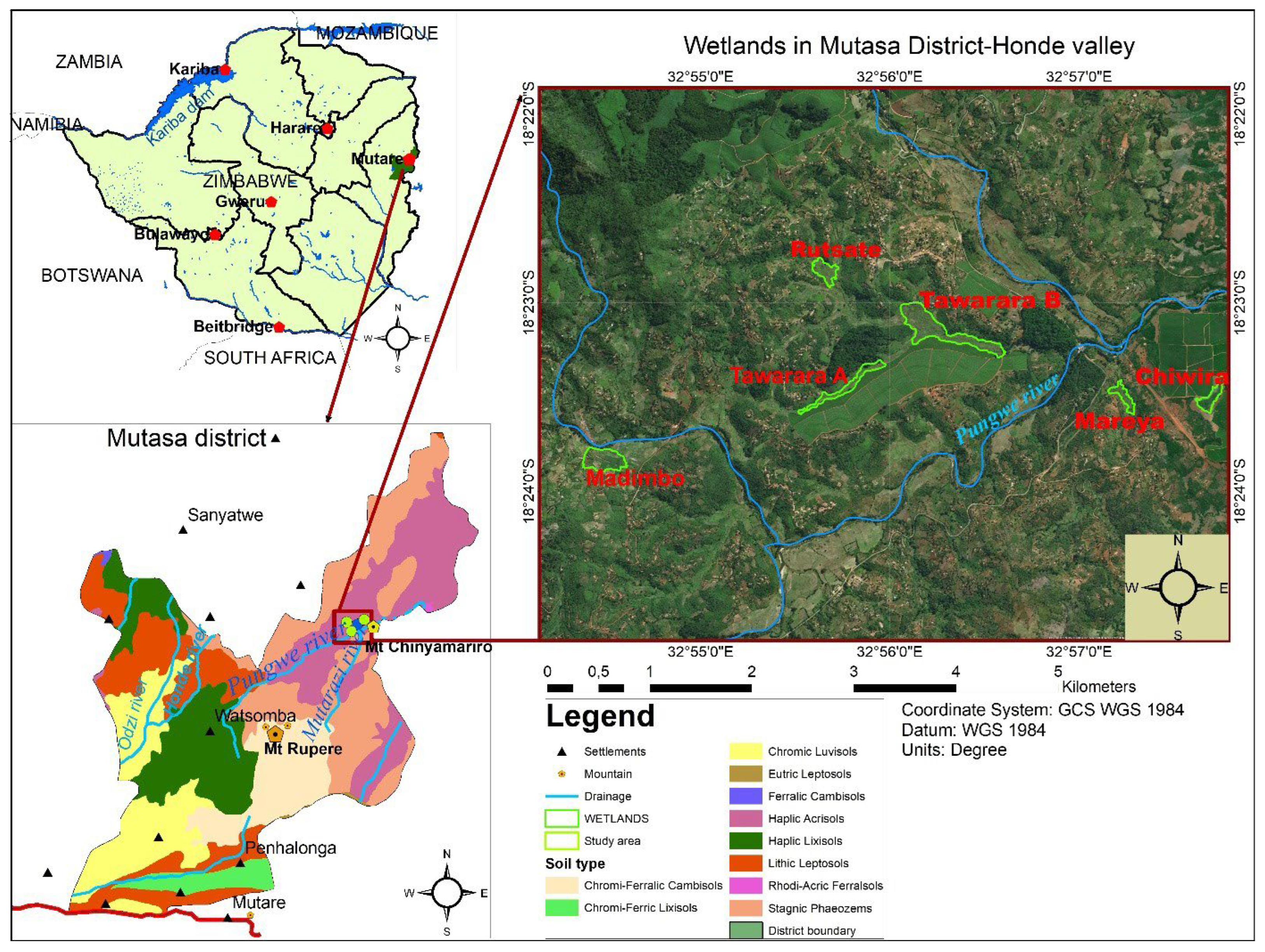
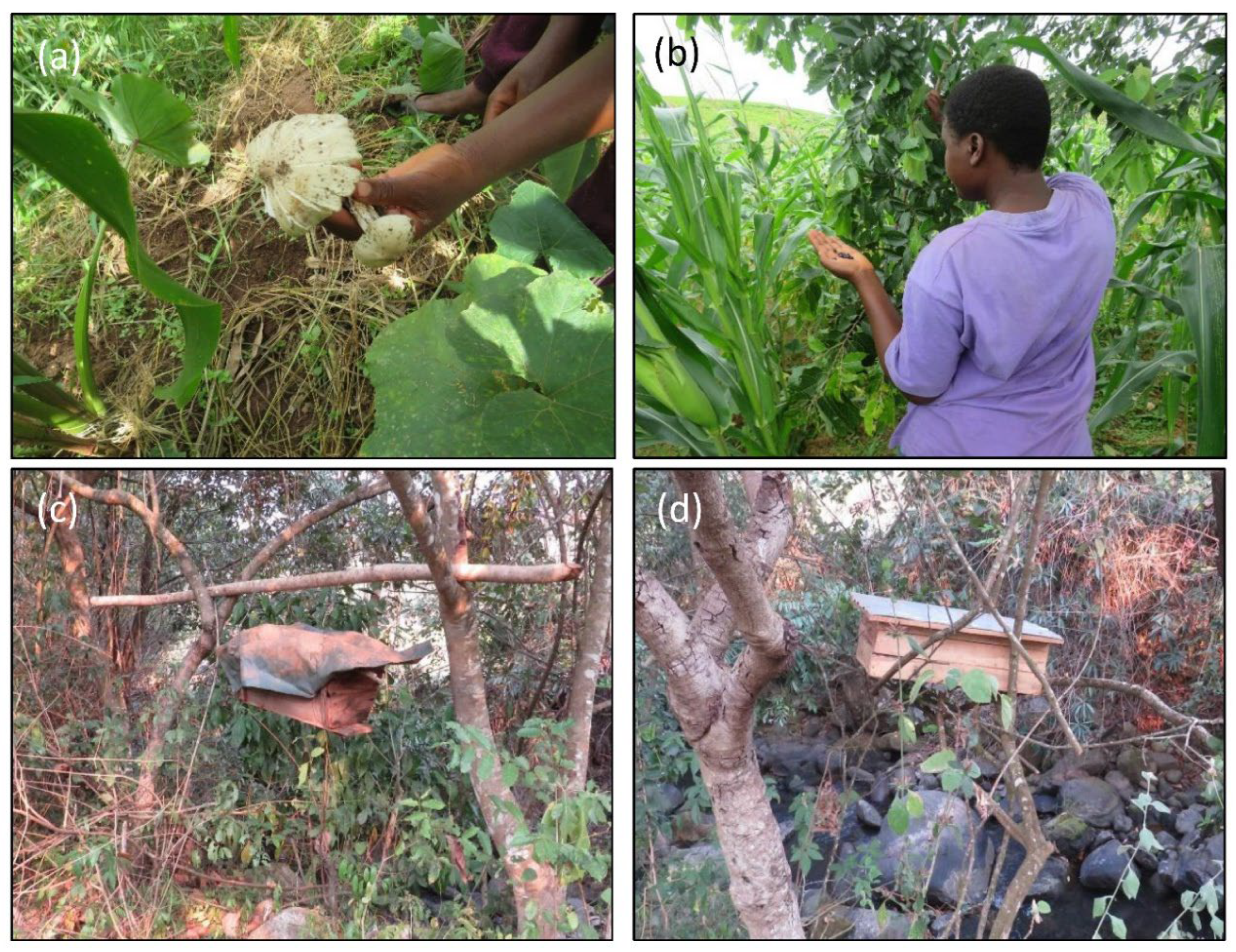
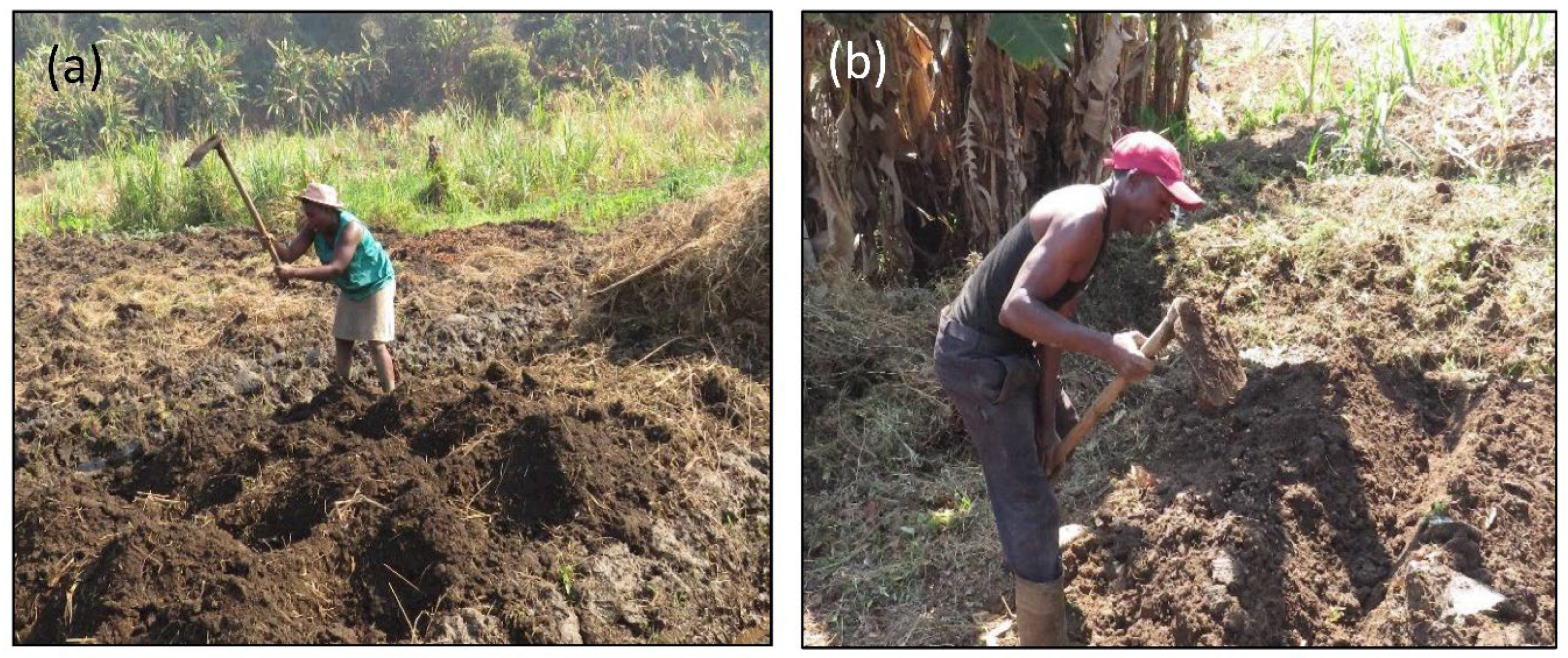
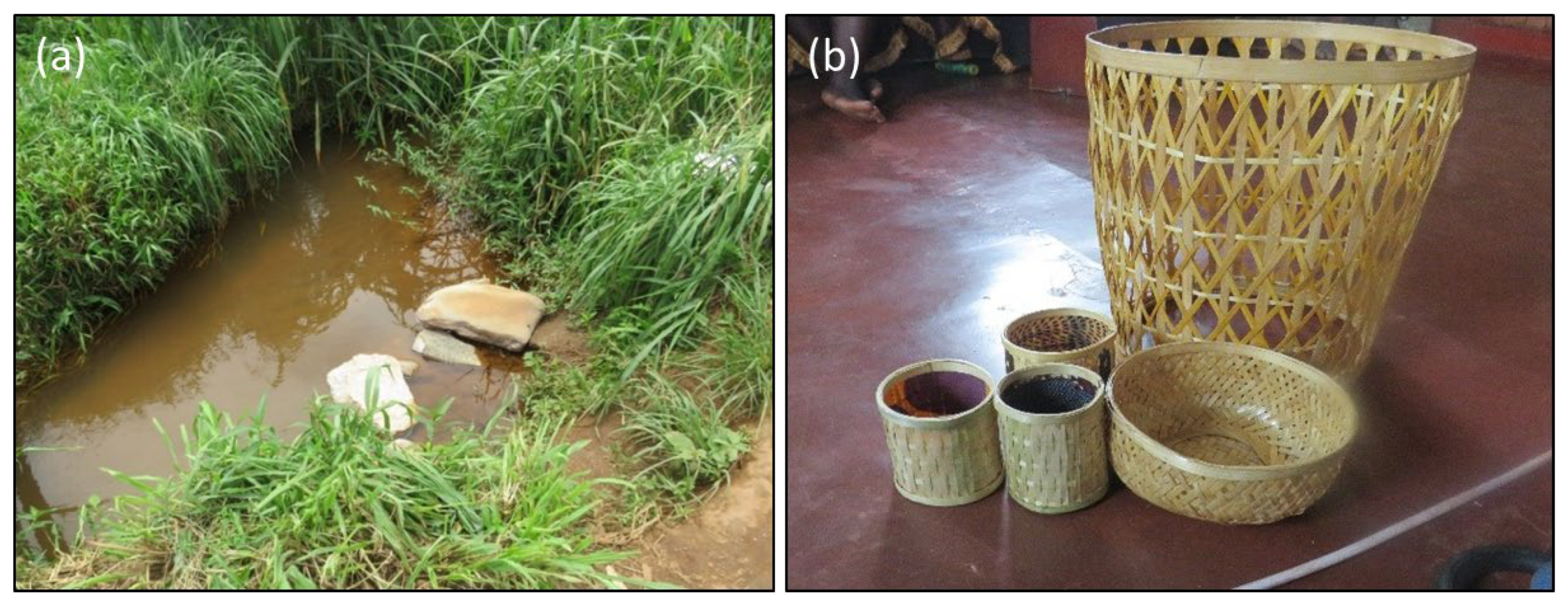
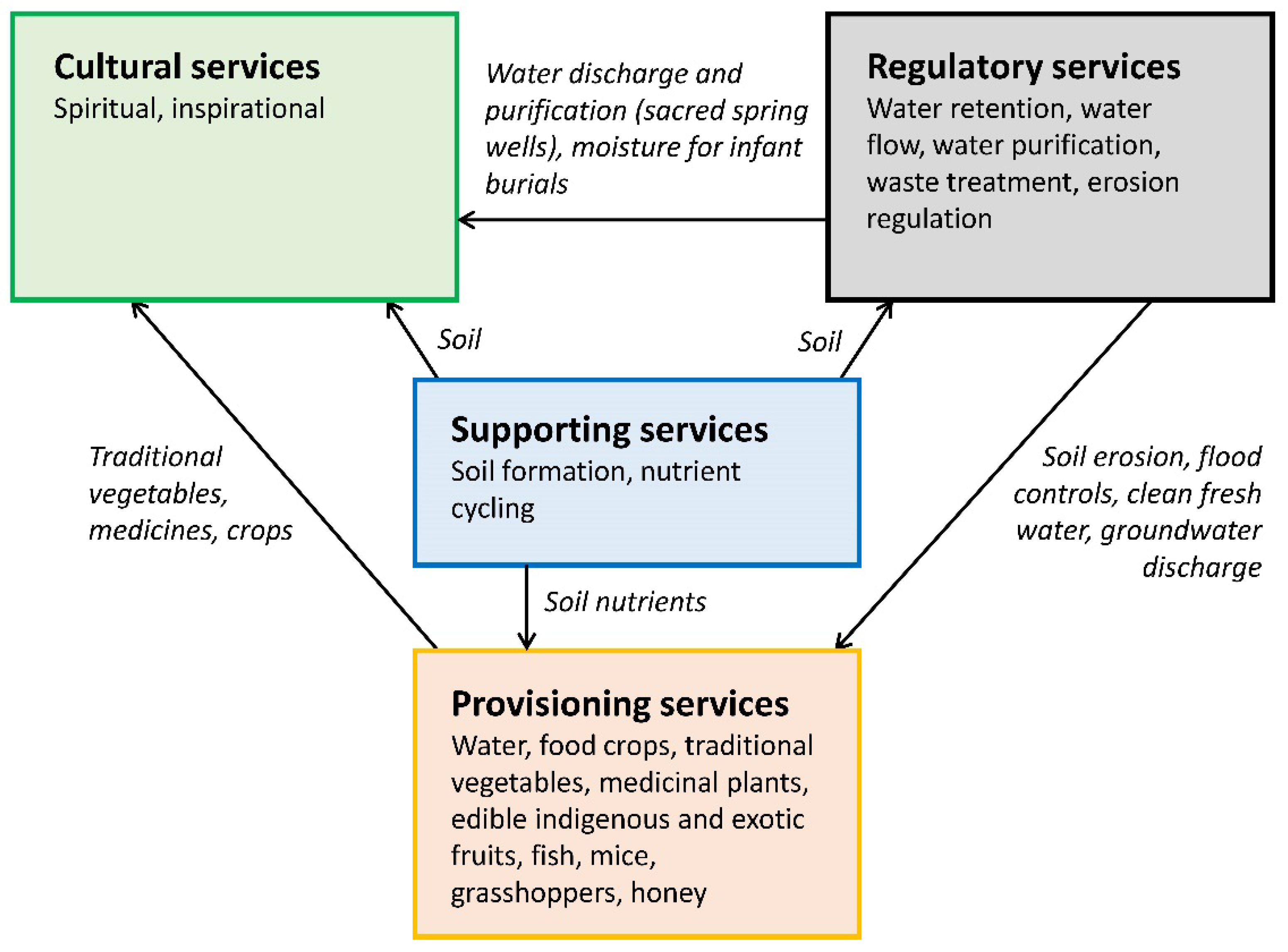
| Botanical Name | Plant Species Local Name | Type of Illness to Be Treated |
|---|---|---|
| Ximenia caffra | Bawa | Backache |
| Breonadia salicina (Adina microcephala) | Muonya | Backache |
| Grewia bicolor | Mungurawe | Stomachache |
| Erythrina abyssinica | Mutiti | Diarrhoea |
| Syzygium cordatum | Muhute | Coughing |
| Scleria foliosa | Jekacheka | Menstrual cramps |
| Carissa bispinosa | Kayanyasika | Backache |
| Zingiber officinale Roscoe | Tsangamidzi | Stomachache |
Publisher’s Note: MDPI stays neutral with regard to jurisdictional claims in published maps and institutional affiliations. |
© 2022 by the authors. Licensee MDPI, Basel, Switzerland. This article is an open access article distributed under the terms and conditions of the Creative Commons Attribution (CC BY) license (https://creativecommons.org/licenses/by/4.0/).
Share and Cite
Mandishona, E.; Knight, J. Feedbacks and Trade-Offs in the Use of Wetland Ecosystem Services by Local Communities in Rural Zimbabwe. Sustainability 2022, 14, 1789. https://doi.org/10.3390/su14031789
Mandishona E, Knight J. Feedbacks and Trade-Offs in the Use of Wetland Ecosystem Services by Local Communities in Rural Zimbabwe. Sustainability. 2022; 14(3):1789. https://doi.org/10.3390/su14031789
Chicago/Turabian StyleMandishona, Emmah, and Jasper Knight. 2022. "Feedbacks and Trade-Offs in the Use of Wetland Ecosystem Services by Local Communities in Rural Zimbabwe" Sustainability 14, no. 3: 1789. https://doi.org/10.3390/su14031789
APA StyleMandishona, E., & Knight, J. (2022). Feedbacks and Trade-Offs in the Use of Wetland Ecosystem Services by Local Communities in Rural Zimbabwe. Sustainability, 14(3), 1789. https://doi.org/10.3390/su14031789






